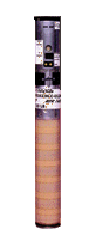


AN/SSQ-62B/C/D/E Directional Command Activated Sonobuoy System (DICASS)
Sonobuoy
 The AN/SSQ-62B/C/D/E Directional Command Activated Sonobuoy System (DICASS)
sonobuoy is an A-size, expendable, non-repairable, command activated sonobuoy. The DICASS,
in conjunction with the monitoring unit(s) signal processing equipment, provides active sonar
range, bearing, and Doppler information on a submerged contact. The DICASS sonobuoy is
designed to develop and maintain attack criteria. The DICASS is usually employed in multiple
sonobuoy patterns, however, they are designed to permit single buoy attack criteria. The
flexibility inherent in the monitoring unit�s control over the various sonobuoy functions enables
optimum sonobuoy employment over a wide range of environmental and target conditions.
The AN/SSQ-62B/C/D/E Directional Command Activated Sonobuoy System (DICASS)
sonobuoy is an A-size, expendable, non-repairable, command activated sonobuoy. The DICASS,
in conjunction with the monitoring unit(s) signal processing equipment, provides active sonar
range, bearing, and Doppler information on a submerged contact. The DICASS sonobuoy is
designed to develop and maintain attack criteria. The DICASS is usually employed in multiple
sonobuoy patterns, however, they are designed to permit single buoy attack criteria. The
flexibility inherent in the monitoring unit�s control over the various sonobuoy functions enables
optimum sonobuoy employment over a wide range of environmental and target conditions.
In June 1980 the Navy granted Approval for Service Use (ASU) for two advanced sonobuoys. The AN/SSQ-62 Directional Command Active Sonobuoy System (DICASS) and the AN/SSQ-77 Vertical Line Array DIFAR(VLAD) represented the first major improvements in the sonobuoy field since the AN/SSQ-53 DIFAR was introduced in 1968. These sonobuoys reinforce their article's unique position as the vital link between the search aircraft and "enemy in liquid space". They provided a three-to-five fold improvement over existing active and passive airborne sensors.
The AN/SSQ-62B DICASS may be command
activated to change depth, to activate sonar transmissions and to scuttle the sonobuoy. The
AN/SSQ-62B DICASS operates on one of four preset sonar channels and one of 31 preset RF
channels. These channels are preset by the manufacturer and cannot be changed. Upon
deployment, the AN/SSQ-62B DICASS will initially deploy to a depth of 90 feet. Upon receipt
of a command signal, the transducer will deploy to a depth of 400 or 1500 feet.
The AN/SSQ-62C DICASS also operates on one of
86 preset sonar channels. The channels are preset prior to flight to one of 86 preset RF channels that correspond with the preset sonar channel. Upon deployment, the AN/SSQ-62C DICASS will
initially deploy to a depth of 90 feet. Upon receipt of a command signal, the transducer will
deploy to a depth of 400 feet or 1500/2500 feet. The 1500 or 2500 foot depth option must be
selected through the EFS during preflight.
The AN/SSQ-62D DICASS has been improved with
the replacement of the lithium chemistry battery with a thermal battery. Additionally, the
sonobuoy includes the EFS option of selectable depth families. During preflight, either a shallow
or deep family of depth option shall be selected. If the shallow family is selected, depth settings of
50, 150, or 300 feet are available. If the deep family is selected, depth settings of 90, 400, and
1500 are available. These depth options provide sufficient flexibility for both littoral and open
ocean ASW operations.
The AN/SSQ-62E DICASS includes the following
improvements and modifications to the AN/SSQ-62D DICASS design. It incorporates CFS,
allowing a suitably equipped ASW aircraft to transmit UHF radio commands to the sonobuoy.
These commands select VHF operation (on/off), change RF channel frequency and associated
sonar channel frequency, change sonar frequency independently, and change depth setting. These
features all provide enhancements for both deep water and littoral ASW environments.
Additionally, the AN/SSQ-62E DICASS will include all four available sonar channel frequencies
into a single sonobuoy which provides significant logistics savings.
The
DICASS, upon self-activation, is able to process UHF command signals transmitted by the
monitoring unit. This command activated, active sonobuoy provides range, bearing and Doppler
information on active sonar contacts. The monitoring platform is capable of commanding the
transducer to deeper depths, activating sonar transmission, including pulse mode and pulse
duration changes, and sonobuoy scuttle. Upon receiving a UHF command signal from the
monitoring unit and decoding the signal for the proper address codes, the DICASS sonobuoy
emits, as selected, either a continuous wave or FM "ping." The transducer array emits pulses,
which are omnidirectional on the horizontal plane and beamformed on the vertical plane. The
received signal is amplified and filtered prior to transfer to the compass and multiplexer
subassembly where a magnetic bearing reference is provided. This signal is then routed through
the cable assembly to the surface unit where it is applied to an FM carrier for VHF transmission.
The monitoring platform receives the signal for recording, processing, and analysis.
Sources and Resources
http://www.fas.org/man/dod-101/sys/ship/weaps/an-ssq-62.htm
Maintained by Robert Sherman
Originally created by John Pike
Updated Sunday, April 23, 2000 7:24:33 AM
 The AN/SSQ-62B/C/D/E Directional Command Activated Sonobuoy System (DICASS)
sonobuoy is an A-size, expendable, non-repairable, command activated sonobuoy. The DICASS,
in conjunction with the monitoring unit(s) signal processing equipment, provides active sonar
range, bearing, and Doppler information on a submerged contact. The DICASS sonobuoy is
designed to develop and maintain attack criteria. The DICASS is usually employed in multiple
sonobuoy patterns, however, they are designed to permit single buoy attack criteria. The
flexibility inherent in the monitoring unit�s control over the various sonobuoy functions enables
optimum sonobuoy employment over a wide range of environmental and target conditions.
The AN/SSQ-62B/C/D/E Directional Command Activated Sonobuoy System (DICASS)
sonobuoy is an A-size, expendable, non-repairable, command activated sonobuoy. The DICASS,
in conjunction with the monitoring unit(s) signal processing equipment, provides active sonar
range, bearing, and Doppler information on a submerged contact. The DICASS sonobuoy is
designed to develop and maintain attack criteria. The DICASS is usually employed in multiple
sonobuoy patterns, however, they are designed to permit single buoy attack criteria. The
flexibility inherent in the monitoring unit�s control over the various sonobuoy functions enables
optimum sonobuoy employment over a wide range of environmental and target conditions.


